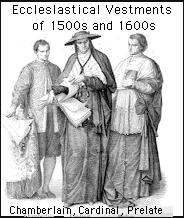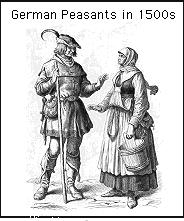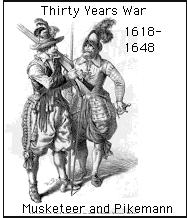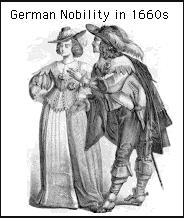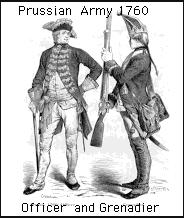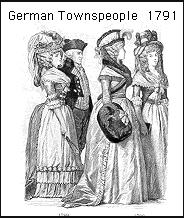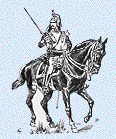Dates Important In German History Continued.....
-
1500 - Criticism of abuses of the Catholic church becomes public and
desire for changes stirs religious ideas and theories in German
states
-
- 1517 - Martin Luther nailed his "theses" of abuses of "indulgences" to the church door in Wittenberg
- Conflicts was long and bitter and continued
-
Costumes worn by the general peasant communities of Germany in the 16
th c.
-
- 1525 - the Grand Master of the Teutonic Knights Albert I of Brandenburg became a Protestant which ended the German Catholic Order in Prussia. The order was picked up and continued by the Catholic German states who's Emp. was a Hapsburg and Catholic
-
Germany is divided between Catholics [Hapsburg and the Holy Roman
Empire) and Reform, also, known as Protestants [Hohenzollerns and others
who became Lutherans, Calvinists, Zwinglians].
-
1525 - Remmick-Hubert Family History:
- Felix Ocshner mto Fronegg Grosswiller. in 1525 in the Great Cathedral, Zurich, Switzerland by Ulrich Zwingli, the founder of the Zwinglians,
-
1525 - Remmick-Hubert Family History:
-
Hungarian nobles elected John [Janos] I
, House
of Zapolya, King of Hungary . This act of the Hungarian nobles
rejected the Hapsburgs who tried to take the terrritory of Hungary
at the death of John I Zapolya, King of Hungary in 1540 but his son
John II Zappolya rejected the Hapsburg claim of sucession, fought for his
land but failed and was thereafter known as the "Pretender"
(d..1571). Hapsburg took Hungary
- John I m. Elisabeth, dau. of Sigismund I, King of Poland [House of Anjour-Piast-Jagellon]. Elisabeth's brother was Sigimund II, King of Poland. Her father's brother was Wladislaw II, King of Bohemia who's dau., Anne, m. Ferdinand I, King of Bohemia and Holy Roman Emp. (House of Hapsburg) who upsurped John II .....
- 1533 - 1584 Tsar Ivan "the Terrible" of Russia called to his country German officers, technicians, craftsmen, merchants and scholars and were settled outside the wall on "German Street", Moscow and here the first "German Evangelical Lutheran Officers' Church was built of wood.....
-
1618 - 1619 Heidelberg University
-
Remmick-Hubert Family
History:
H. [Heinrich] Laurentius [Lorenz] Roemich ( Roemig / Remig
/ Remichius / Roemigius) from Neustadt am Weinstrasse
[Wine Road] of Landau, Palatinate [a German state] entered as a studentthe
University of Heidelberg.
- Young Laurentius was the second student [the first being Jacobus Bawer] who had received a grant founded by the Knight Friedrich von Hirschhorn.
- Because of the outbreak of the Thirty Years War 1618-1648 [as it was to be labeled later by historians], Laurentius left the university and joined the army to fight ...
-
Remmick-Hubert Family
History:
H. [Heinrich] Laurentius [Lorenz] Roemich ( Roemig / Remig
/ Remichius / Roemigius) from Neustadt am Weinstrasse
[Wine Road] of Landau, Palatinate [a German state] entered as a studentthe
University of Heidelberg.
-
1618 to 1648 - Thirty Years War
-
- 1640 - Frederick Wilhelm I (Brandenburg-Hollenzollern) accession to the Brandenburg throne
- 1648 - Treaty of The Peace of Westphalia is the historical mark that ended this period of time
-
Costumes of German nobility in the middle of the 17 th c.
-
- 1701 - Frederick III , "the Great Elector" of Brandenburg and Sovereign Duke of Prussia becomes Frederick I [Hohenzollern] crowned as King "in" Prussia and unites Brandenburg and Prussia into one large Protestant German state and becomes a powerful rival of the Catholic Hapsburgs of Austria who hold the crown of the Holy Roman Empire
-
1703 The numbers of Germans [Cathlic and Lutherans, not known if the
author of this data included the German Jews] who had already emigrated to
the larger cities in Russia were:
- 50,000 Germans living in St. Petersburg
- 20,000 Germans in Moscow
-
1713- 1740 The Prussian King Frederick Wilhelm I "The Soldier
King" established a centralized state government with the back
up of a very strong and well drilled army
-
He did not have cabinet members, however, he often called a group
of his friends together and this group came to be known as the "tabagie"
[smoking group]. One of the members was old
Colonel von Derschau.
- Remmick-Hubert Family History: Derschau was chosen by King Frederick Wilhelm I as the chief inquister of the crown prince Frederick [the king's son and future Frederick II "the Great"] who was accused of being a deserter with his friends von Katte , who was executed, and von Keith, who escaped to Britian.... After Frederick appeared to have been headed for the execution block, he was spared after a lenghtly time of religious lessons and various other punishments....
-
He did not have cabinet members, however, he often called a group
of his friends together and this group came to be known as the "tabagie"
[smoking group]. One of the members was old
Colonel von Derschau.
-
1722-1726 First wave of about 15,000 Germans migr. to the new frontier
known as Banat, which is around the area of the city of Temesvar
(Temeschburg) and near the fortress of Arad under Hapsburg Emp.Karl VI
of Austria-Hungary.
-
One of the colonies was Perjamosch / Arad, Banat, Austria-Hungary
-
Hubert Family
Migration from Germany to Perjamosch / Arad, Banat, Austria-Hungary
date unknown.
- See 1772 - Hubert
-
Hubert Family
Migration from Germany to Perjamosch / Arad, Banat, Austria-Hungary
date unknown.
-
One of the colonies was Perjamosch / Arad, Banat, Austria-Hungary
- 1740 - 1786 Frederick II of Prussia [Hohenzollern] is crown and known later as Frederick II "the Great"
-
1740 War of Austrian Succession fought because France, Prussia, Saxony,
Spain and Bavaria refused to recognize Maria Theresa's succession to
the throne of the Holy Roman Empire after the death of her father
Charles IV [Hapsburg]. They all wanted what they felt was their share of
Charles IV's inheritance. But Maria Theresa was crown Empress and fought
to keep Austria-Hungary the size it was at her father's death.
-
1740 Dec. - The First Silesian War
-
One of the Prussian officers who fell from his wounds was
Maj.-Gen. von der Trenck of the Prussian
Calvary and Knight of the Military Order, Lord of Scharlack,
Schakulack and Meichen d. Dec.1740 in Silesia from 14 wounds suffered from
Battle of Glogau of the Silesian War.
- He was married to the niece of the first Grand Councillor at Glogau, ____ Derschau (1742) of Prussia. His wife's father was the President of the High Court of Koenigsberg, East Prussia.... Des. date back to the Military Order of Livonia and Courland. His cousin was Franz von Trenck of Austria who was for a time Governor of Calabria, Italy then Governor for Leitschau in Selesia... Franz's son, Frederick, who had become Empress Maria Theresa's champion when he and his mounted thousand irregular's shouted and raised passed her with swords waving in the salute of the new Empress...., fought against Frederick II the Great and came close to capturing him ....
-
One of the Prussian officers who fell from his wounds was
Maj.-Gen. von der Trenck of the Prussian
Calvary and Knight of the Military Order, Lord of Scharlack,
Schakulack and Meichen d. Dec.1740 in Silesia from 14 wounds suffered from
Battle of Glogau of the Silesian War.
-
1740 Dec. - The First Silesian War
-
1741 - Edenkoben / Palatinate's Citizens [some documents might read
Kaiserslautern] migr. to Penn., USA.
-
List:
- Valentine Roemmich with wife Anna Barbara, nee Kuhn and children and other members of his family: Sons Jacob, Daniel, Peter and Lorenz. Father, Peter. Brother Lorenz
-
List:
-
1744 - Second Silesian War
- The son of Maj.-Gen. v.d. Trenck was Baron (Freiherrn) Frederick von der Trenck, became part of Frederick II's personal staff and was his Ordance Offier in the begining of this conflict
-
1748 - German ancestors of Hummel-Hubert Migration to
Austria-Hungary
-
Ulmbach / Banat, Austria-Hungary
- Philip Goetz poss fr. Soetern / Saarland. Wife is not mentioned. His son Jakob was born here in 1748
- Sophia Schodt (Schott) b. 1721 Nickenich / Koblenz, Rheinland-Palatinate migr. to Ulmbach and would be the second wife of Philip Goetz.
-
Ulmbach / Banat, Austria-Hungary
-
1752 - German Ancestors of Remmick - Hubert's Migration from Edenkoben
/ Palatinate's Citizens [some documents might read Kaiserslautern] migr.
to Penn., USA.
-
List:
-
Anna
Barbara Spohn, dau. of Nicolaus and Anna, nee Schenck, Spohn, and widow
of Hans Nicholas Bosch rem. in 1688 to widower Hans Nicolaus Schuster. Anna,
As Frau Schuster, migrates with her fourth husband to Nantmeal n. French
Creek in Chester County, Penn., USA with some of their families. [
See Generation
11 Bosch m. Spohn] Others who migr. from Edenkoben of this
year were:
- Ketty to Philadelphia
- Johan Diether Marckbach
- Wilhelm Lenhardt
- Philip Jacob Wack with wife Anna, family, and Andreas Mack
- Heinrich Weidner with wife Elisabeth, nee Beez from Leinsweiler , and family
- Philipps Carl Schenckle with wife Maria Eliz. , nee Zimpelmann
- Philipps Schenckel
- Heinrich Schenckel
- Georg Kehrt who is listed as having been from Ilbeshein , with family
- Jacob Welde with wife Anna Cath., nee Croissant
- Martin Gruen
- Abraham Sontag
- Nicklauss Koenig with wife Maria Marg., nee Stuber, with sons Gottfried and Peter
- Nicklaous Reuther with wife and children
- Greorg Welde with wife Anna Maria, nee Keibel from Iggelheim
- Christoph Mu4eller with wife Anna Barb., nee Kayser
-
Anna
Barbara Spohn, dau. of Nicolaus and Anna, nee Schenck, Spohn, and widow
of Hans Nicholas Bosch rem. in 1688 to widower Hans Nicolaus Schuster. Anna,
As Frau Schuster, migrates with her fourth husband to Nantmeal n. French
Creek in Chester County, Penn., USA with some of their families. [
See Generation
11 Bosch m. Spohn] Others who migr. from Edenkoben of this
year were:
-
List:
-
1753-4
-
German Ancestors of Remmick - Hubert's Migration: to "NewRussia" [southern
Russia]
-
Baron
(freiherrn) Frederick von der Trenck in Russia
- Trenck's cousin gained him the position of Captain in the Russian Calvary
- His social position raises to Gentleman-of-the-Chambers by Tsarina Elizabeth of Russia
- Meets the future Catherine II "the Great" who is soon, thereafter, pregnant with the future Paul I
- 1754 -1765 When Trenck is on is way to his mother's funeral in Danzig, he is kidnapped by Frederick II the Great's men, taken to Magdeburg Prison where is held without accusation, trial or hope of every leaving
- See 1794 for more details
-
Baron
(freiherrn) Frederick von der Trenck in Russia
-
German Ancestors of Remmick - Hubert's Migration: to "NewRussia" [southern
Russia]
-
1755
-
Saltpeter Rebellion
-
German ancestors of Hummel-Hubert migration.
-
Ulmbach / n. Temesvar, Banat, Austria-Hungary (founded in ____)
- Martin Berger (b. 1696 Indlekofen n. Waldshut & Tiengen,[Black Forrest area] Baden-Wuerttemberg, a wealthy farmer, rebelled with 105 others against the Bishop of St. Blasien's high taxes, was arrested, given a life sentence of exile and deported from Waldshut to the Banat. His wife Anna, nee Fluegell, and family joined him... His farm in Oberalphen /Waldshut & Tiengen , Rheinland was acutioned off for 685 [gold] fl. which paid his debt in taxes and the rest was sent to him in Banat. His son-in-law's, Balthasar Gottstein's, father's family was also exiled and settled in Ulmbach with the Bergers.
-
Ulmbach / n. Temesvar, Banat, Austria-Hungary (founded in ____)
-
German ancestors of Hummel-Hubert migration.
-
Saltpeter Rebellion
-
1756- 1763 Prussia and Austria fought the Seven Years' War
-
Prussian Officer of guard battalion and Grenadier in 1760 under
Frederick II "the Great"
-
-
Prussian Officer of guard battalion and Grenadier in 1760 under
Frederick II "the Great"
-
1763 Peace of Hubertsburg was signed between Austria, Prussia and
Saxony
- Rivalry continued between Frederick II "the Great" [Protestant; Hohenzollern] of Prussia and Empress Maria Theresa [Catholic; Hapsburg] of Austria for the leadership of Germany [Holy Roman Empire].
-
1763 after - Often called the time of "englighted absolutionism" in
Prussia and Austria. This meant all citizens [from peasant to the heir
of Holy Roman Empire] in Austrian must absolutely obey their Emperor
or Empress and in Prussia the peasant to the heir of the Prussian states
must obey their King absolutely
- There were some economic reforms.
- Abolishment of torture of offenders.
- There was some improvement in status of Jews
- The First Emancipation of the peasants.
- Education was promoted... .
- 1763 - 1862 Small to large groups of Germans migrated to Russia. In the early years the Russian Empress Catherine II "the Great", who had been born a minor German princes, had offered land and the promise that the men would not have to service in the military [Manifesto of 22 July 1763.] , and her des. into Alexander III's time period
-
1763 - 1768 Germans from Hesse, Rhineland, Palatinate, Saxony,
Wuerttemberg, Prussia, West Prussia, Brandenburg, and Danzig migrated
to Russia:
- Volga, Reibensdorf near Petersburg, Belowesh, Alt-Schwedndorf, Alt-Danzig, Josefstal, Fisherdorf, Jamburg near the Dnieper and Choritza
-
1763 - 1770 - Second Wave of German Migration Schwabenzug
(Schwaben Migration) to Banat, Austria-Hungary occured under
Maria Theresa (Hapsburg) and often called "Thersian migr..... Some estitmate
about 4,000 migr.. They were often times called "the defensive farmers" who
were ex-soldiers settleing in a new frontier area that had been Rumania
{Romania]. Many of the earlier settlers {First Wave] had dwindled due to
raids by the Turks, wars, etc. and new settlers were needed
-
ca. 1765 - German ancestors of Hummel-Hubert migrated
to Banat Austria-Hungary
-
Sackelhausen / n. Temesvar / Banat, Austria-Hungary [early settlers
were housed in a near by Romanian village until their homes were completed
in Sax / Szakhalhasz /Sackelhausen in 1766].
- Joseph Hummerl from Trier [presently in Rheinland-Pfalz] to Sackelhausen by 1766 He would marry in 1781 to Anna Maria Mutsch who had left her home village _____ in 1752
- Sebastian and Cunigunde, nee Braun, Kuehn. He was from Reimsbach / Pfalz and she was from Rinderhirt / Buesbeld and Holzhauer [land of Baron von Zandt]. They were m. 1732 in Nunkirchen....From here they traveled to Reimsbach to neu-Bettingen / Saarland to Jahrmarkt then back to Bettingen [10th child , Nikolaus was born here in 1752]then to Sackelnausen... ca. 1766
- ca. 1775 Theobald and Rosina, nee Kauffmann, Messmer with family migr. to Sackelhausen from Surbourg , Elass (Alsace)
- Other families related to Hummel from Germany to Sackelhausen:
-
Perjamosch / Arad, Banat, Austria-Hungary (founded in 1722
n. the fortress of Arad
- before 1772 - Franz Xaver Hubert b. ca. 1744 m. 1772 in Perjmaosch to Anna Maria Fixmer. Migr. poss. from Serrig / Trier, Rheinland-Palatinate . Wife may have been fr. Urexweiler / St. Wendel, Saarland.
-
Other Familyies relat4ed to Hubert who migr. to Perjamoasch were:
- Deller
- Eisler poss. fr. Lornhoff / Baden-Wuerttemberg,
- Endes
- Engelberger fr. Lippa, Black Forrest area, Baden-Wuerttemberg,
- Focht (Vocht),
- Giehh,
- Gillich,
- Horas fr. Saarland,
- Jost fr. [St.] Bliesen -Niederhafen n. St. Wendel [Black Forrest], Baden-Wuerttemberg
- Kuhn,
- Roemer fr. ____,
- Schuch fr. Bettenburg / Luxembourg,
- Weckmann fr. Fuerst / Kr.-Duerkheim a. d. Weisstrasse, Rhineland-Palatinate,
- Zillich fr. [St.] Bliesen -Niederhafen n. St. Wendel [Black Forrest], Baden - Wuerttemberg
-
Sackelhausen / n. Temesvar / Banat, Austria-Hungary [early settlers
were housed in a near by Romanian village until their homes were completed
in Sax / Szakhalhasz /Sackelhausen in 1766].
-
ca. 1765 - German ancestors of Hummel-Hubert migrated
to Banat Austria-Hungary
-
1784 - German Ancestors of Remmick - Hubert's Migration: to "New Russia"
[southern Russia]
- Peter Philipp Michael Pfaff b. bef. 1743 and his first wife family migrated in 1794 from Moersfeld, Kircheim-Bolanden, Palatinate [Germany] to Torza, now known as Savino Selo, a Batschka village, which was part of the Ungarn area in Austria-Hungary Since that time, the area became part of Yugoslavia and, now, Slovenia. Near Belgrade.
- The Danube River flows through Belgrade, therefore, the people who traveled to Batschka and later to Russia on this waterway....
- See Pfaff 1806
- 1786 - 1797 Frederick Wilhelm II, the nephew of Frederick II "the Great", b. 1744, inherited the Prussian throne and all the old generals who were incapable of fighting the French Revolutionary Armies who were invading the border towns of the German states..... after July 1792.....
-
1791
-
History continues

